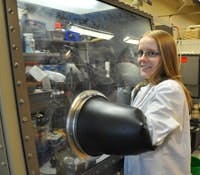Better Hydrogenation Catalysts Beckon
Iron-based nanoparticle catalysts promise to improve the economics of transfer hydrogenations while lessening their environmental impact, report researchers at the University of Toronto. Their work reportedly demonstrates for the first time highly active asymmetric catalysis using zero-valent nanoparticles not based on precious metals.
Such hydrogenations now rely on precious metal catalysts. "…Using iron catalysts is not only much less toxic but it is also much more cost effective," says Jessica Sonnenberg, a graduate student who is lead author of a recent paper on the development in Science. "By going to iron from precious metal catalysts we have already significantly decreased the cost of using these catalysts," she notes. "Our discovery of functional surface nanoparticles opens the door to using much smaller ratios [of expensive organic ligands]." This could substantially cut the cost of catalyst synthesis, she notes.
"The next step will be to take advantage of the fact that these are nanoparticles doing the catalysis. The nice thing about nanoparticles is that all the catalysis takes place on the surface… So, theoretically, we should be able to use half as much of the expensive ligand relative to the metal center to get the same activity. This alone would make these catalysts all the more valuable. The other goal is to make the catalyst reusable — if we can make the nanoparticles a little bit bigger, they should be able to be separated from a reaction mixture magnetically and reused, again adding to the catalysts' value."
"These catalysts are quite robust and long-lived compared to more conventional catalysts. An important point is that they also don't racemize products after prolonged exposure — a common problem with highly active catalysts. As a result of this, they would be quite efficient as recyclable catalysts if we can accomplish magnetic separation," Sonnenberg says.
"They are air sensitive, but this is a very common problem among hydrogenation catalysts," she notes. "The nanoparticle catalysts are not as fast as conventional catalysts, but this would be less important if they could be recycled several times. The more important problem is the selectivity; enantioselectivity is dependent on substrate, but is typically not as good as conventional catalysts."
The catalysts may particularly suit production of chiral alcohols in the pharmaceutical industry, she believes.

